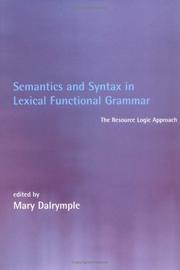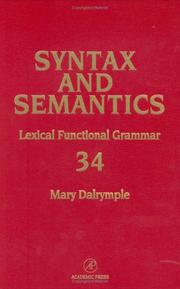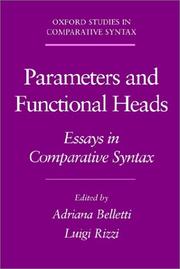| Listing 1 - 10 of 111 | << page >> |
Sort by
|
Book
ISSN: 01657763 ISBN: 9027271585 9789027271587 1299794750 9781299794757 9789027206046 902720604X Year: 2013 Volume: v. 137 Publisher: Amsterdam : John Benjamins Pub. Co.,
Abstract | Keywords | Export | Availability | Bookmark
 Loading...
Loading...Choose an application
- Reference Manager
- EndNote
- RefWorks (Direct export to RefWorks)
The theory of FDG claims that deontic modality can be either participant-oriented or event-oriented, both distinctions forming part of the Representational Level. However, there is evidence from Spanish and a number of other languages that event-oriented deontic modality can be coded twice, with different values in one and the same State-of-Affairs. We will therefore distinguish between objective and subjective deontic modality, where the latter has scope over the former. On the basis of the ways in which the expressions of subjective and objective deontic modality interact with tense and othe
Functional discourse grammar. --- Functional grammar --- Discourse analysis --- Functionalism (Linguistics)
Book
ISBN: 1282196480 9786612196485 3110205378 9783110205374 9781282196483 3110198673 9783110198676 6612196483 Year: 2008 Publisher: Berlin New York Mouton de Gruyter
Abstract | Keywords | Export | Availability | Bookmark
 Loading...
Loading...Choose an application
- Reference Manager
- EndNote
- RefWorks (Direct export to RefWorks)
The articles in this volume analyse the noun phrase within the framework of Functional Discourse Grammar (FDG), the successor to Simon C. Dik's Functional Grammar. In its current form, FDG has an explicit top-down organization and distinguishes four hierarchically organized, interacting levels: (i) the interpersonal level (language as communicational process), (ii) the representational level (language as a carrier of content), (iii) the morphosyntactic level and (iv) the phonological level. Together they constitute the grammatical component, which in its turn interacts with a cognitive and a communicative component. This comprehensive approach to linguistic analysis is also reflected in this volume, which contains rich and substantial contributions concerning many different aspects of the noun phrase. At the same time, the analysis of a major linguistic construction from various perspectives is an excellent way to test a new model of grammar with regard to some of the standards of adequacy for linguistic theories. The book contains several papers dealing with matters of representation and formalization of the noun phrase (the articles by Kees Hengeveld, José Luis González Escribano, Jan Rijkhoff and Evelien Keizer). Other contributors are more concerned with the practical application of the model with regard to discourse-interpersonal matters (Chris Butler, John H. Connolly), whereas the chapters by Dik Bakker and Roland Pfau and by Daniel García Velasco deal with morphosyntactic issues. In all, the variety of issues addressed and the range of languages considered prove that one of the important advantages of the FDG model is precisely the fact that grammatical phenomena can be treated from a semantic, pragmatic, morpho-syntactic, phonological or textual perspective in a coherent fashion.
Grammar, Comparative and general --- Functional discourse grammar. --- Functional grammar --- Discourse analysis --- Functionalism (Linguistics) --- Noun phrase --- Subject (Grammar) --- Noun phrase. --- Complex nominals --- Subject --- Nominals --- Linguistics --- Philology --- Functional Grammar. --- syntax.
Book
ISBN: 9789027263117 9027263116 9789027201942 9027201943 Year: 2018 Publisher: Amsterdam ; Philadelphia : John Benjamins Publishing Company,
Abstract | Keywords | Export | Availability | Bookmark
 Loading...
Loading...Choose an application
- Reference Manager
- EndNote
- RefWorks (Direct export to RefWorks)
This volume presents a collection of papers using the theory of Functional Discourse Grammar (FDG) to analyse and explain a number of specific constructions or phenomena (external possessor contructions and binominal constructions, negation, modification, modality, polysynthesis and transparency) from different perspectives, language-specific, comparative and typological. In addition to applying the theory to the topics in question, these papers aim to contribute to the further development of the theory by modifying and extending it on the basis of new linguistic evidence from a range of languages, thus providing the latest state-of-the-art in FDG. The volume as a whole, however, does more than this, as separately and together the papers collected here aim to demonstrate how FDG, with its unique architecture, can provide new insights into a number of issues and phenomena that are currently of interest to theoretical linguists in general.
Functional discourse grammar --- Functional grammar --- Discourse analysis --- Functionalism (Linguistics) --- E-books
Book
ISBN: 3110632446 311063242X 9783110632422 Year: 2019 Publisher: Berlin: de Gruyter,
Abstract | Keywords | Export | Availability | Bookmark
 Loading...
Loading...Choose an application
- Reference Manager
- EndNote
- RefWorks (Direct export to RefWorks)
Both compounds and multi-word expressions are complex lexical units, made up of at least two constituents. The most basic difference is that the former are morphological objects and the latter result from syntactic processes. However, the exact demarcation between compounds and multi-word expressions differs greatly from language to language and is often a matter of debate in and across languages. Similarly debated is whether and how these two different kinds of units complement or compete with each other. The volume presents an overview of compounds and multi-word expressions in a variety of European languages. Central questions that are discussed for each language concern the formal distinction between compounds and multi-word expressions, their formation and their status in lexicon and grammar. The volume contains chapters on German, English, Dutch, French, Italian, Spanish, Greek, Russian, Polish, Finnish, and Hungarian as well as a contrastive overview with a focus on German. It brings together insights from word-formation theory, phraseology and theory of grammar and aims to contribute to the understanding of the lexicon, both from a language-specific and cross-linguistic perspective.
Konstruktionsgrammatik. --- Kontrastive Linguistik. --- Lexicon. --- Phraseme. --- Phraseologie. --- Phraseology. --- Word-formation. --- Wortbildung. --- LANGUAGE ARTS & DISCIPLINES / Linguistics / Morphology. --- Lexical-functional grammar --- Lexical grammar
Book
ISBN: 1316756785 1316767272 1107170729 1316621790 1316762238 9781316767276 9781107170728 Year: 2018 Publisher: New York, NY
Abstract | Keywords | Export | Availability | Bookmark
 Loading...
Loading...Choose an application
- Reference Manager
- EndNote
- RefWorks (Direct export to RefWorks)
Prosody is generally studied at a separate linguistic level from syntax and semantics. It analyses phonetic properties of utterances such as pitch and prominence, and orders them into phonological categories such as pitch accent, boundary tone, and metrical grid. The goal is to define distinctive formal differentiators of meanings in utterances. But what these meanings are is either excluded or a secondary concern. This book takes the opposite approach, asking what are the basic categories of meaning that speakers want to transmit to listeners? And what formal means do they use to achieve it? It places linguistic form in functions of speech communication, and takes into account all the formal exponents - sounds, words, syntax, prosodies - for specific functional coding. Basic communicative functions such as 'questioning' may be universally assumed, but their coding by linguistic bundles varies between languages. A comparison of function-form systems in English, German and Mandarin Chinese shows this formal diversity for universal functions.
Versification. --- Functional discourse grammar. --- Functional grammar --- Discourse analysis --- Functionalism (Linguistics) --- Meter --- Metrics --- Prosody --- Authorship --- Poetics --- Rhythm --- Stanzas

ISBN: 0262041715 0262271176 0585077576 9780262271172 9780585077574 9780262041713 Year: 1999 Publisher: Cambridge, Mass. MIT Press
Abstract | Keywords | Export | Availability | Bookmark
 Loading...
Loading...Choose an application
- Reference Manager
- EndNote
- RefWorks (Direct export to RefWorks)
Lexicology. Semantics --- Grammar --- Grammar, Comparative and general --- -Lexical-functional grammar --- Semantics --- Formal semantics --- Semasiology --- Semiology (Semantics) --- Comparative linguistics --- Information theory --- Language and languages --- Lexicology --- Meaning (Psychology) --- Generative grammar --- Comparative grammar --- Grammar, Philosophical --- Grammar, Universal --- Philosophical grammar --- Linguistics --- Philology --- Syntax --- Grammar, Comparative --- Lexical-functional grammar --- Languages & Literatures --- Philology & Linguistics --- Lexical-functional grammar. --- Semantics. --- Syntax. --- Grammar, Comparative and general Syntax --- SEMANTIQUE --- Grammaire comparée et générale --- Syntaxe

ISBN: 0126135347 0585492212 184950010X 9780585492216 9781849500104 9780126135343 Year: 2001 Volume: 34 Publisher: San Diego Academic Press
Abstract | Keywords | Export | Availability | Bookmark
 Loading...
Loading...Choose an application
- Reference Manager
- EndNote
- RefWorks (Direct export to RefWorks)
Volume 34 of Syntax and Semantics is a thorough and accessible overview and introduction to Lexical Functional Grammar (LFG), a theory of the content and representation of different aspects of linguistic structure and the relations that hold between them. The book motivates and describes the two syntactic structures of LFG: surface phrasal organization is represented by a context-free phrase structure tree, and more abstract functional syntactic relations like subject and object are represented separately, at functional structure.The book also presents a theory of semantics and the syntax-semantics interface in which the meaning of an utterance is obtained via deduction from semantic premises contributed by its parts. Clear explication of the formal aspects of the theory is provided throughout, and differences between LFG and other linguistic theories are explored. The theory is illustrated by the analysis of a varied set of linguistic phenomena, including modification, control, anaphora, coordination, and long-distance dependencies. Besides its interest to linguists, LFG also has practical applications in computational linguistics and computer science.This book offers thorough overview of the state of the art in Lexical Functional Grammar. It presents clear explanation of the formal tools of the theory. It also offers introduction to the 'glue' semantics, a theory of the syntax-semantics interface. It also presents in-depth syntactic and semantic analysis of a variety of linguistic constructions.
Grammar, Comparative and general --- Lexical-functional grammar. --- Syntax. --- Lexicology. Semantics --- Grammar --- -Lexical-functional grammar --- Semantics --- Formal semantics --- Semasiology --- Semiology (Semantics) --- Comparative linguistics --- Information theory --- Language and languages --- Lexicology --- Meaning (Psychology) --- Generative grammar --- Comparative grammar --- Grammar, Philosophical --- Grammar, Universal --- Philosophical grammar --- Linguistics --- Philology --- Syntax --- Grammar, Comparative --- Lexical-functional grammar --- Grammaire lexicale fonctionnelle --- Grammar, Comparative and general Syntax --- Semantics.
Book
ISBN: 9027215669 9789027215666 9789027292803 9027292809 1282154923 9781282154926 9786612154928 6612154926 Year: 2006 Volume: 57 Publisher: Amsterdam ; Philadelphia : J. Benjamins,
Abstract | Keywords | Export | Availability | Bookmark
 Loading...
Loading...Choose an application
- Reference Manager
- EndNote
- RefWorks (Direct export to RefWorks)
This article extends the boundaries of Columbia School linguistic semantic theory by applying its analytical constructs to nonlinguistic behaviors, where, as in language, there exist systematicity and arbitrariness: food; construction of social and gender identity; and use of architectural, private, and urban space. Further, meaningful elements of these behaviors vary analogously to Labovian sociolinguistic feature variation. The guiding orientation is that human behavior is structured not by an unmotivated, autonomous culture, but is communicative and social, interpreted by people as signals with meanings; and these meanings are discerned as interpreting power, prestige and identity. Data come primarily from fieldwork in Lamu (Kenya) and Thailand.
Linguistics --- Functionalism (linguistics). --- Functionele linguïstiek. --- Funktionalismus (linguistik). --- Functionalism (Linguistics) --- Functional analysis (Linguistics) --- Functional grammar --- Functional linguistics --- Functional-structural analysis (Linguistics) --- Grammar, Functional --- Grammatical functions --- Structural linguistics --- Philosophy --- Language.

ISBN: 3110154048 311015403X 3110154064 3110154056 9783110155396 9783110218374 3110218372 9783110154061 9786613398642 1283398648 3110218364 9783110154030 9783110154054 9783110154047 9781283398640 9783110218367 Year: 1997 Volume: 20 Publisher: Berlin Mouton de Gruyter
Abstract | Keywords | Export | Availability | Bookmark
 Loading...
Loading...Choose an application
- Reference Manager
- EndNote
- RefWorks (Direct export to RefWorks)
Introduction When one takes a functional approach to the study of natural languages, the ultimate questions one is interested in can be formulated as: How does the natural language user (NLU) work? How do speakers and addressees succeed ...
Functionalism (Linguistics). --- Functionalism (Linguistics) --- Grammar --- Functional analysis (Linguistics) --- Functional grammar --- Functional linguistics --- Functional-structural analysis (Linguistics) --- Grammar, Functional --- Grammatical functions --- Linguistics --- Structural linguistics --- English language --- Syntax. --- Germanic languages

ISBN: 1280442913 1423734823 0195358562 1601299699 9781423734826 9780195087932 0195087933 9780195087949 0195087941 9786610442911 6610442916 0195087933 0195087941 0197722113 Year: 1996 Publisher: New York Oxford University Press
Abstract | Keywords | Export | Availability | Bookmark
 Loading...
Loading...Choose an application
- Reference Manager
- EndNote
- RefWorks (Direct export to RefWorks)
This collection of linguistic essays examines functional heads using the ""principles and parameters"" approach. The main focus is on the general theory of head movement, the properties of derived structures and their parametrization.
Grammar, Comparative and general --- Principles and parameters (Linguistics) --- Lexical-functional grammar. --- Generative grammar --- Language and languages --- Syntax --- Syntax. --- Linguistics --- Philology --- Grammar, Comparative and general Syntax
| Listing 1 - 10 of 111 | << page >> |
Sort by
|

 Search
Search Feedback
Feedback About UniCat
About UniCat  Help
Help News
News